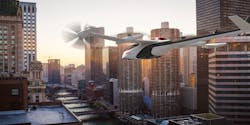Honeywell is developing actuation systems for UAM
PHOENIX – Honeywell is developing a line of lighter-weight, electromechanical flight controls to bring agility and safety to a new breed of urban air vehicles that can take off and land vertically.
These actuators use small amounts of electricity to move control surfaces on the aircraft and are specially designed to withstand the vibrations and power requirements of urban air mobility vehicles, many of which will use multiple propellers or fans to stay aloft. The Honeywell actuators can accept hundreds of tiny adjustments and commands per second from fly-by-wire computers, enabling precise navigation and allowing aircraft designers to challenge the limits of aerodynamics.
The Honeywell actuators use electricity to move control surfaces, eliminating the need for heavy hydraulics, cables or pushrods typically found in larger, more traditional models of aircraft. They are small but mighty — able to withstand harsh weather and the vibrations caused by multiple rotors operating together.
The new actuation solutions are the latest in a series of products Honeywell is developing for the urban air mobility market. They include the Compact Fly-by-Wire System, the IntuVue RDR-84K Band Radar system and lightweight inertial navigation systems.
In recent months, Honeywell has announced strategic alliances with Pipistrel, Volocopter, Vertical Aerospace and Jaunt Air Mobility, and its dedicated teams are laser-focused on collaboration with new players in the emerging urban air mobility market.
